Papers by Dos Santos Silayo
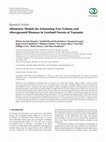
Models to assist management of lowland forests in Tanzania are in most cases lacking. Using a sam... more Models to assist management of lowland forests in Tanzania are in most cases lacking. Using a sample of 60 trees which
were destructively harvested from both dry and wet lowland forests of Dindili in Morogoro Region (30 trees) and Rondo in
Lindi Region (30 trees), respectively, this study developed site specific and general models for estimating total tree volume and aboveground biomass. Specifically the study developed (i) height-diameter (ht-dbh) models for trees found in the two sites, (ii) total, merchantable, and branches volume models, and (iii) total and sectional aboveground biomass models of trees found in the two study sites. The findings show that site specific ht-dbh model appears to be suitable in estimating tree height since the tree
allometry was found to differ significantly between studied forests.The developed general volume models yielded unbiased mean
prediction error and hence can adequately be applied to estimate tree volume in dry and wet lowland forests in Tanzania. General aboveground biomassmodel appears to yield biased estimates; hence, it is not suitable when accurate results are required. In this case, site specific biomass allometric models are recommended. Biomass allometric models which include basic wood density are highly recommended for improved estimates accuracy when such information is available.
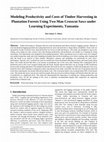
Timber harvesting in Tanzania still uses semi-mechanized and labour–intensive logging systems. Ma... more Timber harvesting in Tanzania still uses semi-mechanized and labour–intensive logging systems. Manual or semi-mechanised logging operations by using hand tools are more favoured due to cheap labour availability. These tools are operated by locally recruited crews characterized by low levels of skill and literacy. This study was designed to assess tree cutting crews using two man crosscut saws and develop productivity and production cost models in a learning by doing experiment. The experiments were designed in clear felling operations. Three experiments were set where each crew category was studied using time study and work sampling techniques that involved studying crews before training, after training and after the break at an interval of three months. Descriptive statistics and modelling was performed for each crews‟ performance. Specific crew‟s productivity and cost models have been developed reflecting necessary and unnecessary delay times. The results showed that there is an increase in production rate of the crews after training with a subsequent fall in production rates as the crews resumed cutting after the break. Results showed that there was an average of 40% production increase after training and about 23% production fall after the break for all crew categories. Further the production costs were relatively lower after training as compared to other experiments in the study. Generally, the unit cost of operations observed in the three experiments was mostly affected by labour costs. This is because labour cost accounted about 94% of the hourly costs. This means that since crosscut saw used two people, then any increase in labour charges will linearly affect the unit cost of production at a significant level. This study has demonstrated the importance of training tree cutting productivity and production costs. On the job training of the crews is therefore recommended despite their experience for improved productivity at reduced costs.
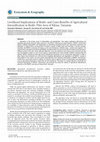
Agriculture is the primary driver of deforestation and degradation. This makes addressing defores... more Agriculture is the primary driver of deforestation and degradation. This makes addressing deforesting and
degrading agricultural practices highly pertinent in the REDD+ planning and implementation. REDD+ interventions
target to mitigate deforestation and degradation by addressing underlying drivers such agricultural expansion into
forestland. In tropical Africa, encroachment of forests in search of fertile virgin land has been a common practice.
Inevitably, the REDD+ processes will impact on the local livelihoods in different ways – positive and negative. The
local-level land use plans promoted under REDD+ are likely to alter how much land a farmer would access and where.
Different groups of the poor will be affected differently. Land use alterations will impact on the local food security
and food systems at large. In view of such impacts, compensations are made integral of REDD+ programming and
delivery. REDD+ projects promote agricultural intensification practices such as conservation agriculture in order to
attain higher food production per unit land while mitigating deforestation and degradation. As REDD+ concept is
being piloted in the country, we have limited understanding of the livelihood implications of REDD+ interventions.
Furthermore, local-scale economic viability of measures used to address drivers of deforestation and degradation
such as agricultural expansion is empirically not well understood. This paper is a modest attempt to illuminate the
livelihood implications of REDD+ interventions and estimate the economic viability of agricultural intensification
practices in the REDD+ pilot area in Kilosa district, Tanzania.
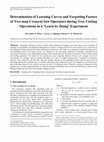
Integrating ecological concerns with the daily operations of logging crews has been an area of in... more Integrating ecological concerns with the daily operations of logging crews has been an area of interest in ensuring for sustainable environmental management in forestry. Learning curves have been found to be a useful tool in scheduling harvesting operations for better performance in the sector. This study was conducted to establish learning curves and forgetting factors of two-man crosscut saw operators in tree harvesting operations in Tanzania. Experienced and inexperienced operators were studied before training, after training and after the break at an interval of three months during clear felling operations. The results for the learning rate were somewhat different between crew category and across experiments. For example, start-up operators had about 67% and 57% higher learning rate as compared to experience operator when studied for the first time and after training. Results on the forgetting function showed some levels of knowledge depreciation for both crews as could be reflected by their productivity levels. For example the experienced crew had a forgetting factor of 9.4% while the start-up crew had 19% forgetting factor. Therefore, training is imperative for the logging crews to realise high performance at reduced environmental damage such as forest soils disturbances and increased logging residues that may arise from improper logging practises.
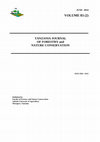
A study was carried out to assess the effect of training and job interruptions on logging crews’ ... more A study was carried out to assess the effect of training and job interruptions on logging crews’ safety during tree cutting using chainsaw and two-man cross cut saws. For each cutting method, experienced and inexperienced/start up crews were studied before training, after training and after break using time study techniques for nine months at intervals of three months. Results show that crews seldom use safety gears. Inexperienced crews suffered more health risks than experienced crews. Most of occupational risks encountered by chainsaw operators’ start up crew were from falling objects (mostly dead branches and pods), falling trees, walking between trees with a running chainsaw as well as walking carelessly on logs and felled trees during bucking. Experienced two-man cross cut saw operators committed fewer risks with about 37% fewer injuries compared to inexperienced crew. Chainsaw operators suffered relatively more injuries compared to two-man cross cut saw operators. However, after training, there were significant improvements in both methods, especially for the start-up crews. There was decreased level of safety consciousness with increased accidents and or risks after the break for both crew categories with start-up crews suffering more injuries. On resuming operations after the break, start-up crews seemed to adhere to safety rules more than the experienced ones. It can be concluded that provision of appropriate safety gears as well as delivery of on job training are important measures for improved performance and lowering accidents and injuries to logging crews.
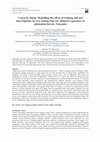
Timber harvesting in Tanzania uses semi-mechanized and labour – intensive logging systems. Manual... more Timber harvesting in Tanzania uses semi-mechanized and labour – intensive logging systems. Manual or semi-mechanized logging operations by using hand tools are more favoured due to cheap labour availability. For example, tree cutting is done manually using two-man crosscut saws, axes or chainsaws. This study was conducted at Sokoine University of Agriculture Training Forest to assess the effect of training and job interruptions for chainsaw operators during tree cutting operations in softwood plantation forests in Tanzania. Tree cutting operations using experienced and inexperienced chainsaw operators were studied in three experiments; before training, after training and after the break. Time study and work sampling techniques were used for data collection. Descriptive statistics and modeling was performed for each crews’ performance. Results show that generally, experienced crew spends lesser time in cutting as compared to inexperienced crews. However, start up chainsaw crew spent 32% higher time for preparation before tree felling. However, the crew showed significant improvement after training unlike the experienced one. The analysis of the delay times start up crew was had a significant proportion of the delay times during the first engagement which decreased substantially in the other two experiments. Generally, there was an improvement of the cutting time after training for all crew categories with decrease after the break. This observation signifies that job interruptions impact the productivity of the crews. Therefore, on job training on resumption of the operations may significantly improve crews’ productivity, safety as well as ensuring product quality.
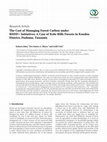
Countries considering participating in a REDD+ mechanism need information on what it would cost t... more Countries considering participating in a REDD+ mechanism need information on what it would cost them to reduce emissions from deforestation and forest degradation. This study was conducted to estimate the cost of managing forest carbon under REDD+ initiatives in Kolo Hills Forest, Kondoa, Tanzania. Socioeconomic and biophysical information was collected through structured questionnaires, focus group discussions, and forest inventory, respectively. Results show that the community participated in managing the forest by undertaking a range of activities such as tree planting, patrolling, and fire protection. The estimated total cost was USD 418,349.38 while the average cost was USD 79.06/ha. The average carbon stored was 19.75 tC ha −1 , which is equivalent to 72.48 tCO 2 ha −1 . Costs incurred by managing the forest in relation to tCO 2 stored were USD 1.0485 tCO 2 e −1 ha −1 . The project was found to be economically feasible at 5%, 10%, 15%, and 20% discount rates with NPVs of USD 107,102,331.83, USD 33,986,255.86, USD 10,312,945, and USD 1,245,905.11, respectively. The internal rate of return was 21.21% which is much higher than the World Bank rate of 15.8% and the Tanzania rate of 14.8%. We therefore conclude that the decision to undertake this REDD+ project was worthwhile and should be favoured against the "do nothing" alternative.
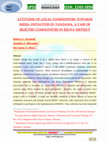
Climate change has turned to be a global issue which is no longer a concern of the environmental ... more Climate change has turned to be a global issue which is no longer a concern of the environmental sector alone, but a cross-cutting and a multidisciplinary issue due to its economic, social, and ecological impacts to the global community, including smallholder farmers in low-income countries. While industrial development is acknowledged to have significant contribution to anthropogenic greenhouse emissions, 25% of all anthropogenic GHG emissions responsible for climate change come from deforestation and forest degradation. Thus reducing emissions from deforestation and forest degradation (REDD+) is important intervention that is necessary for sustainable reduction of emission and enhancement sink capacity using efforts manned by local communities. However, the extent to which local communities are aware of climate change and its impacts have not been studies in REDD+ project areas in Tanzania. A study was therefore conducted in Kilwa District to assess the community awareness and attitude towards REDD+ initiatives, with a particular focus on their willingness to participate in the implementation of REDD+. Data collection was done using both International Journal of Physical and Social Sciences http://www.ijmra.us 256 April 2014 structured and semi-structured interviews. A Logistic regression model was used to determine factors influencing willingness to participate while Cross-tabulation and Likert scale were used to determine the level of awareness and attitudes between different sub-samples. Results indicate that 76% of local communities are aware of impacts of climate change but only 44.5% were aware of the REDD+ objectives and its potential benefits. The level of community awareness has a significant influence (p=0.000) on willingness to participate in REDD+ implementation. Other factors include: Attitude, Income and land size. The study concludes that, community's willingness to participate in REDD+ activities is influenced by many factors but to the greatest extent by awareness. It is recommended that, creation of a proper awareness of the REDD+ objectives to the participating communities is highly need.
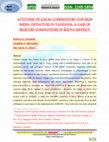
Climate change has turned to be a global issue which is no longer a concern of the environmental ... more Climate change has turned to be a global issue which is no longer a concern of the environmental sector alone, but a cross-cutting and a multidisciplinary issue due to its economic, social, and ecological impacts to the global community, including smallholder farmers in low-income countries. While industrial development is acknowledged to have significant contribution to anthropogenic greenhouse emissions, 25% of all anthropogenic GHG emissions responsible for climate change come from deforestation and forest degradation. Thus reducing emissions from deforestation and forest degradation (REDD+) is important intervention that is necessary for sustainable reduction of emission and enhancement sink capacity using efforts manned by local communities. However, the extent to which local communities are aware of climate change and its impacts have not been studies in REDD+ project areas in Tanzania. A study was therefore conducted in Kilwa District to assess the community awareness and attitude towards REDD+ initiatives, with a particular focus on their willingness to participate in the implementation of REDD+. Data collection was done using both International Journal of Physical and Social Sciences http://www.ijmra.us 256 April 2014 structured and semi-structured interviews. A Logistic regression model was used to determine factors influencing willingness to participate while Cross-tabulation and Likert scale were used to determine the level of awareness and attitudes between different sub-samples. Results indicate that 76% of local communities are aware of impacts of climate change but only 44.5% were aware of the REDD+ objectives and its potential benefits. The level of community awareness has a significant influence (p=0.000) on willingness to participate in REDD+ implementation. Other factors include: Attitude, Income and land size. The study concludes that, community's willingness to participate in REDD+ activities is influenced by many factors but to the greatest extent by awareness. It is recommended that, creation of a proper awareness of the REDD+ objectives to the participating communities is highly need.
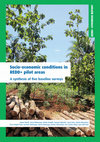
The project aims to increase understanding of how different options for REDD+ design and policy a... more The project aims to increase understanding of how different options for REDD+ design and policy at international, national and sub-national level will affect achievement of greenhouse gas emission reduction and co-benefits of sustainable development and poverty reduction. As well as examining the internal distribution and allocation of REDD+ payments under different design option scenarios at both international and national level, the project will work with selected REDD+ pilot projects in each of the five countries to generate evidence and improve understanding on the poverty impacts of REDD+ pilot activities, the relative merits of different types of payment mechanisms and the transaction costs. This project was financed by NORAD, the Norwegian Development Agency. Many people have been involved in this project in one way or another. We would particularly like to thank the following: Raymond Achu Samndong, who helped develop the research instruments; John Herbert Ainembabaz, who was responsible for the database; members of the country project teams, who assisted in conducting the baseline surveys, focus group discussions and interviews in the field; as well as the MSc students Cecilie Dyngeland and Håvard Alameida Eriksson, who did fieldwork in Tanzania, and Samson Sambian Konlan, who carried out fieldwork in Ghana and who greatly contributed to the overall findings of the study. We would also like to thank Professor Pål Vedeld for his overall contributions to the project. Finally, we thank Maryanne Grieg-Gran for project leadership and for constructive comments to earlier drafts of the report.
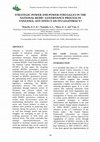
Tanzania is currently undertaking a number of initiatives related to the development of national ... more Tanzania is currently undertaking a number of initiatives related to the development of national REDD+ governance structures. These initiatives, among others, include process to establish a national REDD+ Trust Fund (NRTF) and the National Carbon Monitoring Centre (NCMC). In this paper, the on-going national REDD+ governance structure establishment processes at both local and national levels are analysed. The study focused on REDD+ governance process, the participating actors, power and power struggle and its effects on the political legitimacy underlying the REDD+ governance process. The study was undertaken through intensive review of literature and relevant reports and documents, and dialogue with actors involved in the process. It was found that while REDD+ governance continues to evolve, some non-economic actors are transforming themselves into economic actors and 'Power brokers' in order to enhance their position in protecting their interests during the process. It was noted as well that strategic power and power struggles are emerging as part of the evolving processes at both local and national levels. The study concludes that strategic intervention/decision was required to facilitate smooth process and avoid the stalemate that can be caused by emerging power struggles in the national REDD+ governance structure development process.
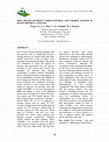
Loss of tree diversity through improper land use practices such as overgrazing and poor farming p... more Loss of tree diversity through improper land use practices such as overgrazing and poor farming practices in tropical areas and other natural ecosystems is one of today's most worrying environmental problems. This study was conducted to assess the impact of farming and pastoralism on tree species diversity in two forests each owned and managed by pastoral and farming communities in Kilosa District. Household survey solicited information on perceptions of local communities on drivers that influenced tree stocking and diversity of their forests. A forest inventory was conducted involving twenty circular in each system plots laid along two transects. In each plot, trees and shrubs with DBH > 5 cm were measured for DBH and height. A total of 48 different species were recorded out of which 75%were tree species and 25% shrubs species. The forest under pastoral system had a Shannon -Wiener Index (H') of 3.13 as opposed to farming system with an index of 2.05. Average stocking for the forest under pastoral system was 235 stem ha-1, whereas that of farming system was 209 stem ha-1. Basal areas of 13m2ha-1 and 6m2 ha-l were recorded for forests under pastoral and farming systems respectively. Standing volume showed the same tendency where 216m3ha-1 was recorded from the forest under pastoral system as opposed to 100.12 m3ha-1 from the other forest. The high loss of species diversity and stocks particularly in the forest under farming system were attributed to anthropogenic disturbances including cutting trees for farm expansion, charcoal making and house construction. Although the assessment on the community perception on the loss of tree diversity in the area showed conflicting interests between the two societies each blaming activities of each community as major causes of forest degradation. This calls for more enforcement of rules and regulations and tree planting in degraded areas predominantly in the farming communities. The study further revealed that the existing tensions over land resource ownership between the two communities of farmers and pastoralists may be contributing factors of unsustainable use of tree species and other forest resources. It is recommended that interventions should be done to settle conflicts over land resource ownership and management between the two villages as well control proliferation and dominance of Acacia nilotica as a way to improve pasture and improve species diversity in the area.
enforce appropriate techniques. Likewise, providing a good working environment that includes safe... more enforce appropriate techniques. Likewise, providing a good working environment that includes safety tools and meals could greatly reduce the physical workload and improve productivity.
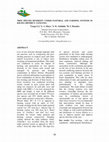
Loss of tree diversity through improper land use practices such as overgrazing and poor farming p... more Loss of tree diversity through improper land use practices such as overgrazing and poor farming practices in tropical areas and other natural ecosystems is one of today's most worrying environmental problems. This study was conducted to assess the impact of farming and pastoralism on tree species diversity in two forests each owned and managed by pastoral and farming communities in Kilosa District. Household survey solicited information on perceptions of local communities on drivers that influenced tree stocking and diversity of their forests. A forest inventory was conducted involving twenty circular in each system plots laid along two transects. In each plot, trees and shrubs with DBH > 5 cm were measured for DBH and height. A total of 48 different species were recorded out of which 75%were tree species and 25% shrubs species. The forest under pastoral system had a Shannon -Wiener Index (H') of 3.13 as opposed to farming system with an index of 2.05. Average stocking for the forest under pastoral system was 235 stem ha-1, whereas that of farming system was 209 stem ha-1. Basal areas of 13m2ha-1 and 6m2 ha-l were recorded for forests under pastoral and farming systems respectively. Standing volume showed the same tendency where 216m3ha-1 was recorded from the forest under pastoral system as opposed to 100.12 m3ha-1 from the other forest. The high loss of species diversity and stocks particularly in the forest under farming system were attributed to anthropogenic disturbances including cutting trees for farm expansion, charcoal making and house construction. Although the assessment on the community perception on the loss of tree diversity in the area showed conflicting interests between the two societies each blaming activities of each community as major causes of forest degradation. This calls for more enforcement of rules and regulations and tree planting in degraded areas predominantly in the farming communities. The study further revealed that the existing tensions over land resource ownership between the two communities of farmers and pastoralists may be contributing factors of unsustainable use of tree species and other forest resources. It is recommended that interventions should be done to settle conflicts over land resource ownership and management between the two villages as well control proliferation and dominance of Acacia nilotica as a way to improve pasture and improve species diversity in the area.
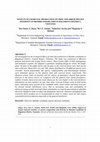
We investigated on the ecological effects of charcoal production in Miombo woodlands in Bagamoyo ... more We investigated on the ecological effects of charcoal production in Miombo woodlands in Bagamoyo District, Coastal Region, Tanzania. The study was conducted in Mbwewe general land forest and Uzigua forest reserve. These forests differ in both management and utilization regimes. We adopted a systematic sampling design for which, 48 sample plots; 30 plots in the public forest and 18 plots in the reserved forest were laid out for data collection. About 81% tree and 19% shrubs distributed in 59 different species were recorded. Acacia polyacantha sub species camplyacantha and Brachystegia boehmii were dominant species in the general land and reserved forest respectively. The Shannon-winner index of diversity and the indices of dominance showed high species diversity in the forest reserve as compared with the general land. Stand parameters; number of stems, basal area and wood volume per ha were higher in the reserved forest. Distribution of stem numbers by size class show reversed J-shape trend in both forest types, indicating active growth of the woodland while, wood volume and basal area per ha showed normal distribution curve. Due to increasing costs and unreliability of electrical energy to both rural and urban communities we urge the government to subsidize electrical charges in order to reduce the demand for charcoal. Intensive management and restrictive forest product use is recommended in order to reduce wood use and ensure sustainable forest production especially in the general land forest.








Uploads
Papers by Dos Santos Silayo
were destructively harvested from both dry and wet lowland forests of Dindili in Morogoro Region (30 trees) and Rondo in
Lindi Region (30 trees), respectively, this study developed site specific and general models for estimating total tree volume and aboveground biomass. Specifically the study developed (i) height-diameter (ht-dbh) models for trees found in the two sites, (ii) total, merchantable, and branches volume models, and (iii) total and sectional aboveground biomass models of trees found in the two study sites. The findings show that site specific ht-dbh model appears to be suitable in estimating tree height since the tree
allometry was found to differ significantly between studied forests.The developed general volume models yielded unbiased mean
prediction error and hence can adequately be applied to estimate tree volume in dry and wet lowland forests in Tanzania. General aboveground biomassmodel appears to yield biased estimates; hence, it is not suitable when accurate results are required. In this case, site specific biomass allometric models are recommended. Biomass allometric models which include basic wood density are highly recommended for improved estimates accuracy when such information is available.
degrading agricultural practices highly pertinent in the REDD+ planning and implementation. REDD+ interventions
target to mitigate deforestation and degradation by addressing underlying drivers such agricultural expansion into
forestland. In tropical Africa, encroachment of forests in search of fertile virgin land has been a common practice.
Inevitably, the REDD+ processes will impact on the local livelihoods in different ways – positive and negative. The
local-level land use plans promoted under REDD+ are likely to alter how much land a farmer would access and where.
Different groups of the poor will be affected differently. Land use alterations will impact on the local food security
and food systems at large. In view of such impacts, compensations are made integral of REDD+ programming and
delivery. REDD+ projects promote agricultural intensification practices such as conservation agriculture in order to
attain higher food production per unit land while mitigating deforestation and degradation. As REDD+ concept is
being piloted in the country, we have limited understanding of the livelihood implications of REDD+ interventions.
Furthermore, local-scale economic viability of measures used to address drivers of deforestation and degradation
such as agricultural expansion is empirically not well understood. This paper is a modest attempt to illuminate the
livelihood implications of REDD+ interventions and estimate the economic viability of agricultural intensification
practices in the REDD+ pilot area in Kilosa district, Tanzania.
were destructively harvested from both dry and wet lowland forests of Dindili in Morogoro Region (30 trees) and Rondo in
Lindi Region (30 trees), respectively, this study developed site specific and general models for estimating total tree volume and aboveground biomass. Specifically the study developed (i) height-diameter (ht-dbh) models for trees found in the two sites, (ii) total, merchantable, and branches volume models, and (iii) total and sectional aboveground biomass models of trees found in the two study sites. The findings show that site specific ht-dbh model appears to be suitable in estimating tree height since the tree
allometry was found to differ significantly between studied forests.The developed general volume models yielded unbiased mean
prediction error and hence can adequately be applied to estimate tree volume in dry and wet lowland forests in Tanzania. General aboveground biomassmodel appears to yield biased estimates; hence, it is not suitable when accurate results are required. In this case, site specific biomass allometric models are recommended. Biomass allometric models which include basic wood density are highly recommended for improved estimates accuracy when such information is available.
degrading agricultural practices highly pertinent in the REDD+ planning and implementation. REDD+ interventions
target to mitigate deforestation and degradation by addressing underlying drivers such agricultural expansion into
forestland. In tropical Africa, encroachment of forests in search of fertile virgin land has been a common practice.
Inevitably, the REDD+ processes will impact on the local livelihoods in different ways – positive and negative. The
local-level land use plans promoted under REDD+ are likely to alter how much land a farmer would access and where.
Different groups of the poor will be affected differently. Land use alterations will impact on the local food security
and food systems at large. In view of such impacts, compensations are made integral of REDD+ programming and
delivery. REDD+ projects promote agricultural intensification practices such as conservation agriculture in order to
attain higher food production per unit land while mitigating deforestation and degradation. As REDD+ concept is
being piloted in the country, we have limited understanding of the livelihood implications of REDD+ interventions.
Furthermore, local-scale economic viability of measures used to address drivers of deforestation and degradation
such as agricultural expansion is empirically not well understood. This paper is a modest attempt to illuminate the
livelihood implications of REDD+ interventions and estimate the economic viability of agricultural intensification
practices in the REDD+ pilot area in Kilosa district, Tanzania.